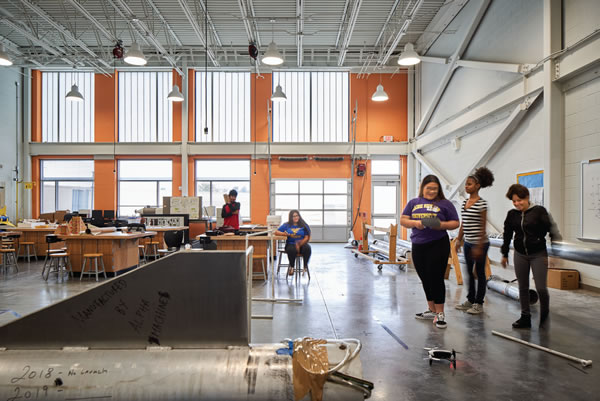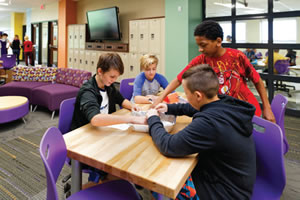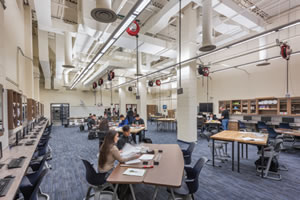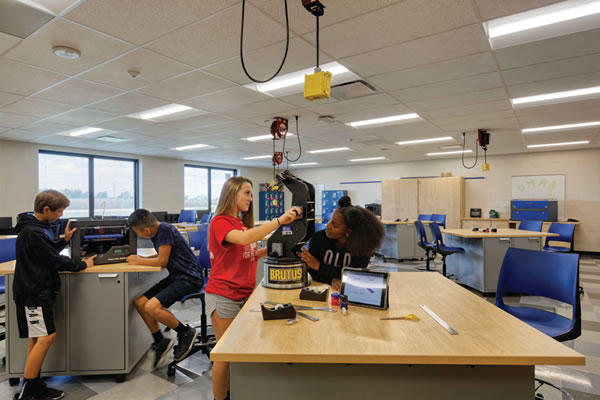Making Makerspaces
In today’s schools, students
are communicating, collaborating
and creating in a variety of flexible
learning environments. For hands-on activities
and experimentation, makerspaces
are must-have spaces for
schools and go-to places for
students within.

PHOTO BY DROR BALDINGER FAIA ARCHITECTURAL PHOTOGRAPHY /
COURTESY OF FANNING HOWEY
The maker movement
emphasizes learning by
doing in a variety of mediums. As it has
progressed, countless variations of makerspaces
are taking shape in response to the
unique needs and cultures of school communities.
But this begs the question: With
so many choices, how do schools create
makerspaces that are right for them?
Types of Makerspaces
Makerspaces come in all different shapes
and sizes, but there are some core characteristics
they share to be successful. Makerspaces
are versatile and flexible environments capable
of accommodating multiple activities
simultaneously, and they emphasize
process over product to promote a
problem-solving mindset. But most
importantly, makerspaces represent a
place in schools where students can be hands
on, where they can experiment and where they
can make mistakes. Makerspaces are a safe
zone for learning by doing, even when that
means being loud and getting messy.
Makerspaces differ based on each
school’s goals, culture and student interests.
Focuses can range anywhere from arts and
crafts to agriculture to multimedia to robotics
and coding. As such, there is a wide range
of technology applications in these spaces.
Tech-heavy makerspaces may include 3D
printers, laser cutters, CNC machines, power
tools, green screens or robotics equipment,
whereas low-tech makerspaces may use hand
tools, art supplies and Legos.

PHOTO BY WILLIAM MANNING PHOTOGRAPHY / COURTESY OF FANNING HOWEY
Spontaneous Making. Independent learning
communities with flex studios at Middletown
Middle School in Middletown, Ohio, allow for
making on the go.
Effective makerspaces aren’t necessarily
those with the most technology or
digital devices. They are, instead, spaces
where students feel socially and emotionally
connected to their peers and can
collaboratively or independently explore at
their own pace. Technology enhances this
experience, but doesn’t drive it.
Makerspace Must-Haves
While each makerspace is unique to
its school community, there are certain
amenities that support a learning-by-doing
mentality. Whether it’s a small renovation
or new construction, consider incorporating
the following into your next makerspace:
- Flexibility: A makerspace is a changing
program, so don’t box yourself in. Fixed
equipment and casework should be universal
enough to accommodate change.
Also, don’t forget to provide plenty of soft
seating and mobile furniture.
- Power & Plumbing: Make sure your students
have the infrastructure they need to
support hands-on learning activities. When
providing power, consider overhead electrical
drops. This strategy keeps the floor clear
and supports flexibility of movement.
- Whiteboards: While students use
technology to collaborate more than ever,
don’t forget to include some old-school
whiteboards to encourage brainstorming
and dreaming out loud.
- Lockable Storage: Makerspaces often
include expensive equipment, especially
at the middle and high school level.
Provide plenty of lockable storage to keep
items safe after the making has subsided.
These must-have elements mean that certain
areas within a school are more appropriate
for conversion to become a makerspace. In
elementary schools, old computer labs located
near the media center are prime candidates
for conversion. At the high school level, look
for underutilized career-technical spaces.
They are often equipped with the appropriate
power and plumbing, and their higher ceilings
give makers more room to move.
But whatever your approach to creating
a makerspace, to make an impact you
must make sure that construction follows
instruction.

PHOTO BY JAMES STEINKAMP PHOTOGRAPHY / COURTESY OF FANNING HOWEY
Endless Possibilities. Makerspace at Round
Lake High School in Round Lake, Illinois, features
movable furniture, overhead power extensions,
computers and art supplies to support a wide
range of activities.
Making an Impact
To create a maker culture that supports
school goals, administrators must understand
the long-term direction of the school’s
curriculum, including what skills they want
students to leave with at graduation. Once
the groundwork for this direction has been
laid, leaders should collaborate with staff
and students to dream up what activities
will best develop those skills. If teamwork,
complex problem-solving and coding skills
are valued to prepare students for future
careers in technology, makerspaces should
support robotics and STEM activities. If
the focus is readying students for careers in
the local agriculture industry, makerspaces
should support the grow lights and aquaponics
systems needed for agronomy and
horticulture learning activities.
Student involvement in the process is
critical for understanding student interests
and how the environment can help them explore
those interests. Giving students a voice
in the direction of their education will not
only lead to better engagement, but it will
create a more representative maker culture
where learners are comfortable exploring
their passions in an experiential setting.
Whether large or small, basic or innovative,
makerspaces should be unlike any
other space in a school. They can be loud,
messy and even a little chaotic at times, but
what’s important is students have a flexible
space for hands-on learning that supports
everything they are making. Especially
mistakes.

PHOTO BY WILLIAM MANNING PHOTOGRAPHY / COURTESY OF FANNING HOWEY
Future-Ready. Robotics activities at Memorial Middle School in Hilliard, Ohio, promote the
school’s STEM curriculum.
This article originally appeared in the School Planning & Management September 2019 issue of Spaces4Learning.
About the Authors
John Gladden, AIA, is a principal and project designer in the Dublin, Ohio office of Fanning Howey, a national leader in the planning and design of learning environments.
Brandon Biniker is an interior designer in the Dublin, Ohio office of Fanning Howey, a national leader in the planning and design of learning environments.